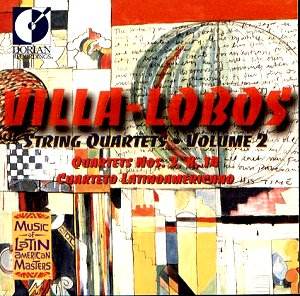Volume Two in the Latin American Quartet’s complete
cycle of the Villa-Lobos Quartets picks up theme of inter-relatedness
instigated by the opener. Once again an early part of the canon
shares disc space with much later works to advantage, and one
moreover that offers intriguing parallels and reflections. The
Third was written in 1916 and is steeped to an unusual degree
for him in Debussyian impressionism. The half tints and shadows
that pervade the opening Allegro are embellished by a yearning
viola line and glinting cello. In the Molto vivo second movement
Villa-Lobos spins one of his pizzicato-led scherzi – propulsive
and colourful. The long slow movement contains references to the
opening one, with pizzicato pedal points and a sense of rarefied
delicacy about it. Those expecting his glittering orchestral panache
to be replicated in flashy superficiality should know that right
from the first quartet Villa-Lobos showed himself a creative assimilator
and tireless enthusiast for the form. Again the slow movement
evinces impressionistic concerns – but the way the solo violin
spins an effortless melody over oscillating lower strings is touching
and beautiful. And then to confound expectation he throws a surprise
– a finale redolent of locomotive chug, jagged and propulsive
and very enjoyable.
The Eighth dates from 1944 and as with the majority
is cast in four conventional sounding movements. A rather stately
canon opens the work but it soon picks up lyricism and the chromaticism
is richly absorbed into the bloodstream of the writing. His slow
movement is introspective and interior in cast, the cello (Villa-Lobos’s
own instrument, of course) taking on an especially eloquent role,
the music spiced with the occasional moment of idiosyncratic colour.
After a rapid and colourful scherzo we have a fugal and dancing
finale; it’s very energetic but it’s also flexible and invigorating,
as is so much of his writing for quartet forces. The Fourteenth
Quartet (1953) has rather terse and short motifs in the opening
Allegro. There’s plenty of strenuous and technically tough writing
but he judges the arc of the movement well, winding down and reasserting
his material with acumen. The heart of the work is the impressive
Andante. The liquidly generous lyricism of this is memorable,
with the first violin casting an enviably open-hearted line underpinned
by the subtlest of harmonic support. The displaced accents of
the Scherzo, with its quixotic sense of motion, are topped by
the brilliantly written finale, full of colour and piquant instrumentation.
As before the documentation – notes by Juan Arturo
Brennan – is excellent. Should you prefer a chronological treatment
of these works try the Danubius Quartet (whom I haven’t heard).
But I found the Latin American Quartet sensitive and thoughtful
interpreters well deserving of your time.
Jonathan Woolf
Other
reviews
Volume
1
Volume
2
Volume
3
Volume
4
Volume
5
Volume
6
